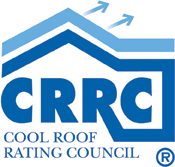Cool Roofs for Hot Projects
With increasingly rigorous roofing code and standards, and promising technologies on the horizon, cool roofs are quickly becoming one of the most effective ways to obtain significant energy savings and environmental rewards. Cool roofs can be the simplest design measure to implement, in both new construction and existing buildings, without compromising project design or performance. Whether a project incorporates cool roof emerging technology or utilizes standard reflective processes, a designer specifying a rooftop now has several resources available to make informed and confident cool roof choices.
LEED Project-The King Abdullah University of Science and Technology-HOK |
The design firm of Hellmuth, Obata and Kassabaum (HOK) designed the King Abdullah University of Science and Technology to be the first LEED certified project in the Kingdom of Saudi Arabia. It is also the largest LEED Platinum project in the world. The project features a 90,000 square foot cool roof combining the following materials:
The project takes design cues from traditional Arabic architectural features developed in response to the harsh climate. These passive design strategies include a shading system that mimics traditional latticework screens called mashrabiya, natural ventilation through solar chimneys, and a compact, staggered building plan that allows building sections to shade each other. These features complement and magnify the cooling effects of the roof.13 Similar to the vernacular design strategies used on the University, cool roofs are not a new idea, being employed around history throughout the world from Greece to Bermuda. |
Â
| ENDNOTES | |
| 1 | http://heatisland.lbl.gov/CoolRoofs/ |
| 2 | www.energystar.gov |
| 3 | http://eetd.lbl.gov/HeatIsland/EnergyUse/Overview/index.html |
| 4 | http://heatisland2009.lbl.gov/docs/231200-akbari-doc.pdf |
| 5 | http://eetd.lbl.gov/HeatIsland/CoolRoofs/ |
| 6 | http://coolroofs.org/documents/ |
| 7 | http://www.energycodes.gov/ |
| 8 | http://www.energy.ca.gov/title24/ |
| 9 | http://coolroofs.org/codes_and_programs.html NOTE: The list of city or state building codes requiring cool roofs, or offering incentives may change from the date this article was published. |
| 10 | http://www.consumerenergycenter.org/coolroof/faq.html#faqs-05 |
| 11 | http://eetd.lbl.gov/HeatIsland/CoolRoofs/Overview/index.html |
| 12 | http://www.sciencenews.org/view/generic/id/57485/ title/Cool_roof_coating_Mechanism_kept_under_wraps |
| 13 | http://www.edcmag.com/Articles/Web_Exclusive/BNP_GUID_9-5-2006_A_10000000000000886986 |
Â
|









